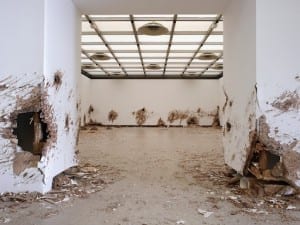Text by Rachel Van Greuning
BALTIC 39 is a new hub for Contemporary Art in Newcastle upon Tyne opens to the public on Friday 6 April. Aesthetica spoke to BALTIC Director Godfrey Worsdale on the gallery’s recent success.
RVG: Firstly, congratulations on the success of the Turner Prize re-locating to the BALTIC. What Impact has the prize had on BALTIC?
GW: Turner Prize 2011 was good for BALTIC, but it was also a success for the prize itself. BALTIC attracted a large and to some extent a new audience for the exhibition and I now sense that London is more enthusiastic about the Prize in 2012.
RVG: BALTIC is expanding with the opening of BALTIC 39; it has been described as a cultural hub for contemporary art – how will it engage with the public?
GW: BALTIC 39 will provide a new and additional offer to that which is to be found at the principal BALTIC site. Visitors will be able to see artists and curators re-evaluating the norms of their practice. Outcomes will be less predetermined. We continue to see a growth in the levels of interest in contemporary art and the programme at BALTIC 39 will offer another layer for engagement.
RVG: The opening of BALTIC 39 broadens the nature of the BALTIC’s engagement with contemporary art, as it is not only being displayed and responded to, but emerging from the centre itself. How do you feel the studios and practitioners-in-residence will change the BALTIC?
GW: BALTIC has always centred it’s programming on a close and careful relationship with artists. Being in the same building as so many resident artists, practice-based professors and post-graduate students will inevitably impact on the way the dialogue around the programme evolves.
RVG: BALTIC 39 will include the presence of Northumbria University; in the BxNU Institute of Contemporary Art and the recent appointment of a BALTIC Professor. How important is research to the BALTIC and what will BALTIC 39 contribute to Art Education?
GW: Learning and engagement at all levels will always be critical to BALTIC’s work, but BALTIC 39 will enable a significant enhancement of the academic research that underpins our work. The partnership with Northumbria University and the establishment of the BxNU institute will create a unique offer.
RVG: BALTIC 39 is a collaboration between BALTIC and Newcastle City Council; how important is the local community and the region to the new space? Is BALTIC 39 going to inform a north-east vernacular of contemporary art in the UK?
GW: Newcastle City Council has been bold in creating a site where the various components within BALTIC 39 can come together. All the signs are that this will greatly enhance what the city and the region has to offer it’s residents and it’s visitors. As with all centres of serious contemporary practice, there is no sense of the vernacular. Artists based in the North East are engaged with and concerned by issues that preoccupy artists across the globe, but I expect our work at BALTIC 39 will enable international links to flourish further.
RVG: How will the architecture and design of the space impact BALTIC 39’s functions and practices?
GW: The exhibition space is situated on the top floor of the building. The large north facing sky-lights provide clean light for the large, square space which is sliced into two rectangular spaces by the double stair-case that takes visitors down through the studios and university spaces. Being on the top of a tall building right in the centre of a city will be an interesting and quite unusual proposition for artists and a large picture window and viewing terrace give clarity to that context. The gallery feels quite formal so it will be interesting to see how different artists address that.
RVG: The first show SWITCH seems to explore and encapsulate BALTIC 39’s intentions with an exploration of the nature of contemporary art practice in the UK. What role will curation and exhibition play in the work of BALTIC 39? What makes this space different as a gallery?
GW: For the opening show, we’ve been incredibly fortunate to have had the collaboration of Phyllida Barlow, who has really embraced the notion of questioning the normal processes and practices of exhibition making. SWITCH will be an exhibition in flux – not resolved at the start – its participants encouraged to revisit it’s component parts and make changes right through to the show’s end. Not everything that happens at BALTIC 39 will work and that is the experimental nature that will characterise it’s programme.
RVG: What are the plans for the rest of 2012?
GW: The rest of the 2012 programme will pursue a similar and tantalisingly uncertain agenda. That agenda will largely be informed by what artists will determine to be fertile ground for consideration. Alongside the main exhibitions, the programme will be interspersed with informal activity, performances and opportunities for salon-style dialogue. Plans are in development to engage individuals or groups of artists or curators from New York to Palestine.
SWITCH: Selected by Phyllida Barlow, 06/04/2012 – 24/06/2012, BALTIC 39, 31-39 High Bridge, Newcastle-upon-Tyne, NE1 1EW. www.balticmill.com/39
Aesthetica in Print
If you only read Aesthetica online, you are missing out. The April/May issue of Aesthetica is out now and includes a diverse range of features from Bauhaus: Art as Life, a comprehensive survey of one of the most influential schools of thought from the 20th century, Growing Up: The Young British Artists at 50, which centres on Jeremy Cooper’s examination of the illustrious career, and the phenomenon that was the YBAs and Behind Closed Doors, an intimate portrait of family life in Cuba from photographer David Creedon.
If you would like to buy this issue, you can find your nearest stockist here. Better yet, subscribe to Aesthetica for a year and save 20% on the printed magazine. To subscribe visit the website or call us on +44 (0) 1904 629 137.





